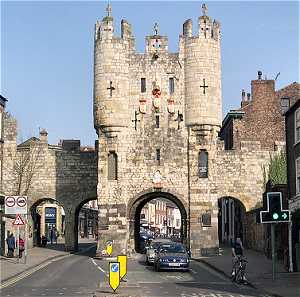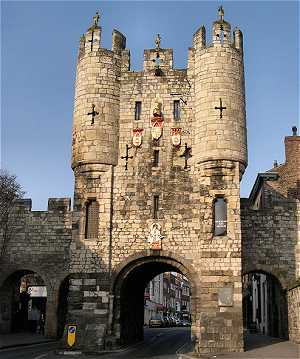Micklegate Bar York, City Walls Gate on Micklegate York England
Micklegate Bar is the most Westerly and main gate through York's walls. It was and is still used by royalty to enter the city of York. Historically it is where heads of traitors were displayed on spikes. Its architecture has had several changes to it. Also, some of the masonry used to build it dates back to Roman times. Original features can still be seen inside the main gates passage walls.
The History of Micklegate Bar
In Olde English, this entrance to the city was called "Micklelith" meaning "great gate". As the main gate to York it was often decorated to receive distinguished visitors. Through the centuries many English Monarchs have passed beneath it, including Queen Elizabeth II most recently.
Referred to by William Shakespeare - War of the Roses
A great historic reference was made to this gate by William Shakespeare. His play Henry VI Part 3 concerned the War of the Roses. The great bard Shakespeare tells us the House of Lancaster's Lord Clifford and Duke of Northumberland captured Richard III of England who was born Richard, 3rd Duke of York. In Act 1 Scene 4, Clifford and Queen Margaret of Anjou (1430 - 1482), wife of Henry IV (King of England 1421 - 1471), both then stabbed him to death.
Queen Margaret's line in the play following this is: "Off with his head and set it on York gates; So York may overlook the town of York."
Other historic references agree more factually that the head of Richard III was put on Micklegate Bar for a short time. This happened after his death at the Battle of Wakefield on 30 December 1460. However after the battle of Towton on 29 March 1461 the victor King Edward IV regained the crown for the House of York. He then removed the head of his father Richard. The heads of some of the captured leaders of the House of Lancaster were then set here. These two battles were fought as a part of the English War of the Roses when the House of York and the House of Lancaster fought for the kingdom of England.
Architecture
Micklegate Bar has four storeys. The main, outer arch and passage walls contain reused Roman masonry and gritstone. However, it is on the other side of the river from the original Roman walls so, it was not a gate way back then.
The upper storeys were built in the 14th century, using magnesium limestone. The statues on top were carved by R. Ridley in 1950 as replacements for earlier ones. It did have Barbican that jutted out westward, to keep pesky invaders at bay. This was removed relatively recently in 1826. However, the doors of it that lead to the walkways around the walls still exist. The wooden inner face the gate was rebuilt in stone by P. Atknison junior in 1827.
In the passage walls that are beneath the outer arch, bricked up doorways and portcullis grooves can still be seen. Due to traffic through the gate, the safest way to view these is in a car waiting for the lights to change!
The arch directly to the left of the main arch, as you look at the front, is a recent addition to accommodate increased road traffic. Also, the smaller arches at the far left and right sides, are recent, to accommodate pedestrians.
Acknowledgements for this article go to William Shakespeare, N. Pevsner and D. Neave.


